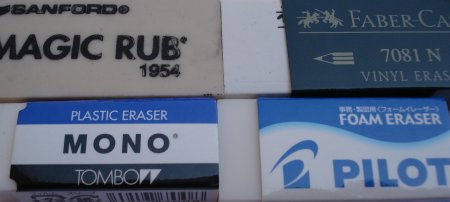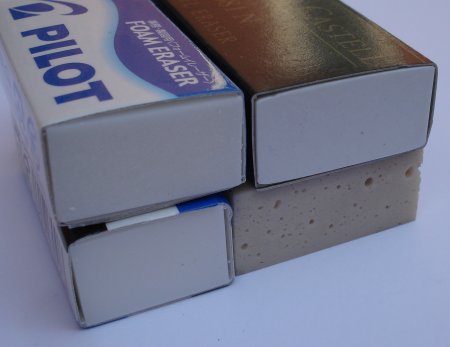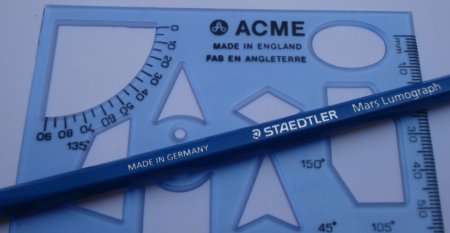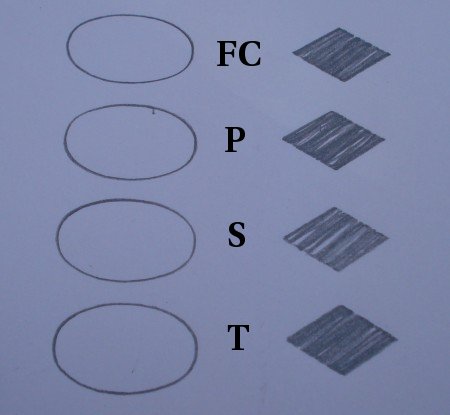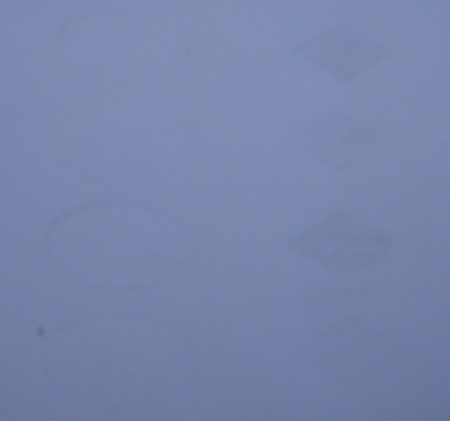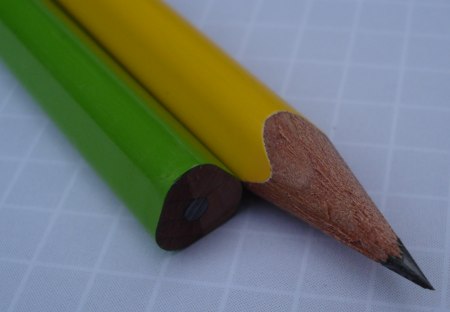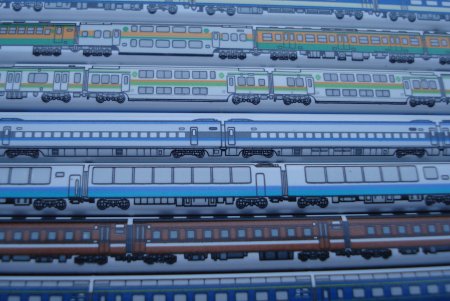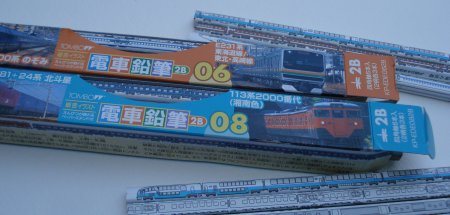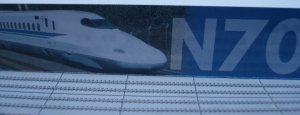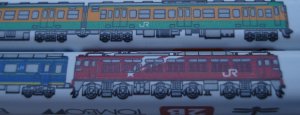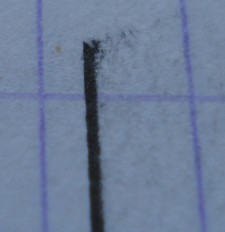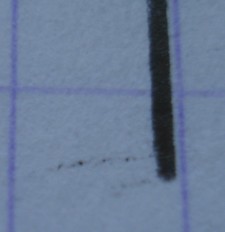
The final part of our evaluation of Japanese woodcase pencils.
Let us mention some things we aren’t testing. First, we’re not testing a wide range of lead hardnesses. Nor are each of these pencils made in a wide range. I would say the chart below speaks for itself: Only two brands offer a full range of hardnesses.
| Range |
| Pencil |
9H |
8H |
7H |
6H |
5H |
4H |
3H |
2H |
H |
F |
HB |
B |
2B |
3B |
4B |
5B |
6B |
| California Republic Palomino |
|
|
|
|
|
|
|
X |
X |
|
X |
X |
X |
|
|
|
|
Craft Design Technology item 17 |
|
|
|
|
|
|
|
|
|
|
X |
|
|
|
|
|
|
| Kita Boshi Hit 9900 |
|
|
|
|
|
|
|
|
|
|
|
X |
X |
X |
X |
X |
X |
| Mitsubishi Hi-uni |
X |
X |
X |
X |
X |
X |
X |
X |
X |
X |
X |
X |
X |
X |
X |
X |
X |
| Pentel Black Polymer 999 |
|
|
|
|
|
|
|
|
|
|
X |
X |
X |
|
|
|
|
| Tombow Mono 100 |
X |
X |
X |
X |
X |
X |
X |
X |
X |
X |
X |
X |
X |
X |
X |
X |
X |
If you want a pencil for long term use or an ongoing project – and want the pencil to be on the market in ten years – that’s very hard to guarantee, but the established pencil makers would certainly be my choice, and I fully expect the Hi-uni and Mono 100 to celebrate many more anniversaries. Pentel is an established company also, but the withdrawal of the 999 alpha doesn’t portend well.
Writing (40 points)
Manufacturers no doubt have specialty instruments for product testing. The rest of us have to trust our senses and observations. This is no doubt quite subjective. I decided to break writing into smoothness, darkness, point, and overall impression sub-categories.
In many cases, I found myself staring at pieces of paper full of pencils marks, looking for very small differences. A first conclusion, apart from the naming of an ultimate victor, is that the reputation of Japanese pencils is well deserved, and that these pencils are better, and in some cases remarkably better, than their marketplace competitors.
Smoothness is definitely appreciated by pencil users. It is the formula of the pencil core that makes the difference here. We want to avoid any gritty or abrasive reaction between the pencil and paper. I tried various techniques, including making marks without viewing, and getting others to test the pencils.
Fortunately, there were some consistent results. A surprise also – no one felt the Mono 100 to be among the smoother pencils. It may be a grading difference, or a reflection of paper choices (110lb artist sketch books were used as well as writing paper), but the result was clear. The three smoother than average pencils were the Palomino, item 17, and Hi-uni. The smoothest pencil? I am really surprised to say that it is the item 17 pencil – a new entry on the market. The Hi-uni was very close second.
Many pencil users appreciate a dark line, but it isn’t always fair to say that one pencil is darker than another, since different brands may have different grading practices. Still, these pencils are all produced in same market, and it is an HB test.
The darkest line comes from the Black Polymer 999. Is the pencil made with another formula, perhaps like a mechanical pencil lead, with polymer substituting for clay? I have no idea, but it ceratinly made the darkest line. The Mono 100 was second, and I couldn’t find much difference among the other pencils.
By “point” – I mean the pencil’s ability to maintain a point, and to not crumble with use.
This is the weak point of the Palomino – the pencil does not hold a point very well, and also visibly crumbles when applying a heavy hand. A top professional animator has made this very observation at this site. No other pencil has the crumbling issue. The item 17 is probably next at wearing down quickly. The name brand pencils excel in this area, with the Black Polymer 999, Hi-Uni and Mono 100 keeping good points.
Alas, the nature of pencil use is that the point always does wear down. But the worn point initiates the ritual of sharpening, which delights us with a renewed sharp point. And the cycle continues.
As to overall impression – compared to many pencils I’ve looked at, these are all a joy to use.
The Hit 9900 and Balck Polymer 999, while first rate, are in very tough company here. Each was best in a category – yet there is much more to a pencil than “grip” and “blackness”. The item 17 and Palomino have great smooth leads, but at a price – for the Palomino in particular.
The Mono 100 was an all-rounder. It performs well at any task – and you get more pencil. I’m not kidding. International standardization of pencil slats has meant a uniformity of the length all pencils around the globe. But the Mono 100 must use a non-standard slat, as it four or five mm longer than other pencils. The HB lead seemed a tad less smooth than others, so it gets a small penalty for that.
Our results:
| Writing |
| Pencil |
Smooth |
Dark |
Point |
Overall |
Score |
| California Republic Palomino |
8 |
8 |
5 |
8 |
29 |
Craft Design Technology item 17 |
10 |
8 |
6 |
8 |
32 |
| Kita Boshi Hit 9900 |
7 |
8 |
7 |
7 |
29 |
| Mitsubishi Hi-uni |
9 |
8 |
8 |
9 |
34 |
| Pentel Black Polymer 999 |
7 |
10 |
8 |
7 |
32 |
| Tombow Mono 100 |
7 |
9 |
8 |
8 |
32 |
Our tests concluded, it it time to assemble the scores for the final results:
| Top Japanese Pencils |
| Pencil |
Appearance |
Grip |
Sharpening |
Erasure |
Fastness |
Writing |
Score |
| California Republic Palomino |
17 |
8 |
8 |
7 |
10 |
29 |
79 |
Craft Design Technology item 17 |
19 |
8 |
8 |
9 |
10 |
32 |
86 |
| Kita Boshi Hit 9900 |
15 |
9 |
8 |
8 |
10 |
29 |
79 |
| Mitsubishi Hi-uni |
14 |
7 |
10 |
10 |
9 |
34 |
84 |
| Pentel Black Polymer 999 |
16 |
7 |
8 |
8 |
8 |
32 |
79 |
| Tombow Mono 100 |
14 |
8 |
8 |
8 |
10 |
32 |
80 |
The top pencil in our test is the Craft Design Technology item 17. The win is based on strong overall scores, and top spot for appearance. The Mitsubishi Hi-Uni came a close second, and was best in three categories, including writing.
As I performed the various tests, I avoided added up the results, and was really surprised to see the evaluation results. I did initially think that one of the highly regarded Mono 100 or Hi-uni was bound to win.
Congratulations to this superb new pencil from Craft Design Technology/Pentel.
